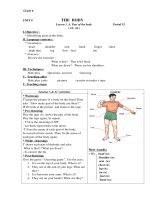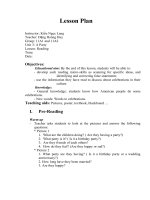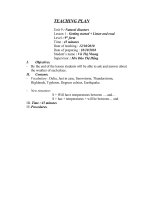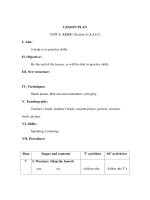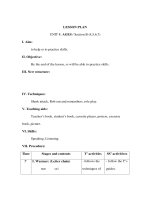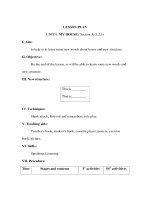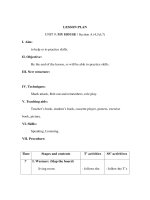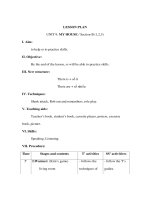LESSON PLAN -UNIT 9
Bạn đang xem bản rút gọn của tài liệu. Xem và tải ngay bản đầy đủ của tài liệu tại đây (105.89 KB, 12 trang )
THPT AN LẠC QUỲNH NHƯ
UNIT 9: UNDERSEA WORLD
Part 1 : READING
I. OBJECTIVES
1/ Educational aim : Students can read and understand the reading passage about the
ocean and undersea world
2/ General knowledge: The seas / the oceans / the undersea world
3/ Skill: Reading for gist and specific information , comprehension reading
II. METHOD: mainly communicative
III. TEACHING AIDS: Cassette player
IV. PROCEDURE
Stages Teacher’s activities Students’ activities
Warm up .
( 5 mn)
Pre-reading
(1o mn)
While-
reading
- Using the film “ Jaws “
- Asking questions :
- What is it ?
- Where does it live?
Introducing the title :
UNDERSEA WORLD
Teacher divides the class into 2 or
3groups.
* Using the map
Write name of the oceans :
* Using the pictures ( p. 94)
Give the name of the sea animals
• Checking & correcting
• Guiding the requirement of task 1
• Noticing some kind of words and
their meaning:
“ Gulf , oversized, biodiversity ,tiny,
Investigate, samples , provide ,
challenges, “
Teacher has the class readthe text
Watching the the film
Answering T’s questions
- It ‘s a shark / dolphin. . .
- In the sea / under the sea
Looking at the map(p. 94)
.
Pair work
the Pacific Ocean /
Arctic/Antarctic / Atlantic. . .
Looking at the picture (p. 94),
Pair work
- Seal, jellyfish, turkey, turtle ,
shark
Silently reading to get the specific
information
Doing Task 1
1/ tiny 4/ Biodiversity
2/ investigate 5/ samples
3/ gulf
Doing task 2
97
THPT AN LẠC QUỲNH NHƯ
Post-reading
(12mn)
again to scan the details then answer
the questions. (p. 96)
Explaining some words:
Submarines , percentage, satellite
photos. . .
Teacher has the students complete the
summary of the reading passage filling
each blank
Read the passage again then answer the
questions
Suggested answers:
1/ 75% of the earth’s surface.
2/ By using mordern devices.
3/ They investigate the seabed and bring
samples of marine life back to the surface
for further study.
4/ We can know a wide range of
information, including water
temperature, depth and the undersea
populations.
5/ They are those that live on or depend
on the bottom like the starfish , those that
move independently of water currents
and those that are carried along by the
currents
6/ Marine life would be at stake if the sea
biodiversirty were not maintained.
Work in pairs : filling each blank
Suggested answers:
1/ three-quarters 5/ biodiversity
2/ mysterious 6/ huge
3/ modern 7/ plants& animals
4/ discoverries 8/ closely connected
Homework: - Write Task 1&2 in the exercises notebook
(1mn) - Preparing B. Speaking (p. 97)
98
THPT AN LẠC QUỲNH NHƯ
UNIT 9: UNDERSEA WORLD
Part 2: SPEAKING
I. OBJECTIVES
Talking about causes and consequences: Offering solutions AND Reporting on
discussion results
1. Educational aim: Students should contribute their parts to the protection of oceans.
2. Knowledge
General knowledge: Through this unit, students learn about types of sea creatures and
undersea life and about how to protect oceans.
Language: Sentences and expressions for talking about causes and consequences, and
for offering solutions.
3. Skills: Fluency in expressing opinions and talking about causes and consequences,
and in offering solutions.
II. METHOD: integrated, mainly communicative
III. TEACHING AIDS: pictures:
IV. PROCEDURE
Teacher’s activities Students’ activities
Warm-up
Show a picture of part of a beach with some
types of rubbish and ask questions:
1) What can you see in the picture?
2) What should we do to keep the ocean clean?
Pre-speaking
T: Should we place rubbish and plastic bags on
the beach? (teacher explains new words and
expressions)
T: Should we place rubbish and plastic bags in
proper dustbins?
T: repeat after me: We should place rubbish and
plastic bags in proper dustbins.
Do the same for b – h
T: Look at your books. Task 1 (p97), and make
sentences with should or shouldn’t then work
with your partner taking it in turns to question
and answer “what we should/ shouldn’t do to
Students’ answers
St: We can see a lot of rubbish on the beach
Students’ answers may vary
St: No, we shouldn’t place rubbish and
plastic bags on the beach.
St: yes, we should place rubbish and plastic
bags in proper dustbins.
St: We should place rubbish and plastic bags
in proper dustbins.
St A: What should we do to protect our
oceans?
St B: We should place rubbish and plastic
99
THPT AN LẠC QUỲNH NHƯ
protect our oceans.”
While – speaking
T: Should beaches be filled with plastic bags,
piece of glass and cigarette butts? (teacher
explains new words and expressions)
T: Why not?
T: What should we do to solve this problem?
Teacher helps students with some suggested
words and expressions. (Write them on the
blackboard.)
Do the same for 2 – 4
Divide the class into 4 groups.
T: work in groups and do task 2 (p97) (each
group works on one topic.)
Post-speaking
T: Report to the class what your group has
discussed.
Teacher comments on the presentation, then
invite another group.
HOMEWORK
To achieve fluency, you have to learn the
expressions and sentences used for talking about
causes and consequences, and for offering
solutions. Write your own reports on the 4
questions in task 2.
Comments
bags in proper dustbins / use water sparingly /
dispose of fishing lines and nets properly / f /
g / h
St A: What shouldn’t we do to protect our
oceans?
St B: We shouldn’t pollute water / dispose of
fishing lines and nets properly in or near the
water / e
St: No. they shouldn’t.
St: Because this makes the sea polluted and
endangers sea plants and animals.
St: We should clean beaches and tell other
people not to litter them.
Students’ answers may vary
St: work in groups to prepare the ideas to
write the report for the presentation.
St (group 1): Beaches are filled with plastic
bags, piece of glass and cigarette butts, and I
don’t think it‘s good because this makes the
sea polluted and endangers sea plants and
animals. In order to solve this problem, I
think we should clean beaches and tell other
people not to litter them.
Students do it at home
100
THPT AN LẠC QUỲNH NHƯ
UNIT 9: UNDERSEA WORLD
Part 3: LISTENING
I. OBJECTIVES
1/ Educational aim : Teach students how to protect the undersea world
2/ General knowledge: Improve students’ knowledge about whales
II. METHOD: communicative method
III. TEACHING AIDS: Cassette player
IV. PROCEDURE
Stages Teacher’s activities Students’ activities Notes
Warm up
(5 mn)
Teacher asks students to tell some
ways to protect the undersea animals
Discuss Pair-work
Pre-
listening
Ask students to discuss 2 questions in
textbook
Give feedback
1. The whale is a mammal
because it raises its young on
milk
2. Because they want to catch
whales for food ,oil, leather
and other products
Ask students to listen and repeat the
new words :
mammal /whaling
Krill / Atlantic
Blue whale / migrate
Pacific / conservation
Answer the questions
Listen and repeat the
new words
Pair-work
While-
Listening
Task 1 :
Ask students to read 3 sentences
Ask students to listen to the tape and
decide whether the sentences are true
or false
Give feedback
1 F 2T 3T
4F 5T
Task 2:
Ask students to read 6 questions
Read silently
Listen and do as
instruction
Read silently
Individual
Group work
101

